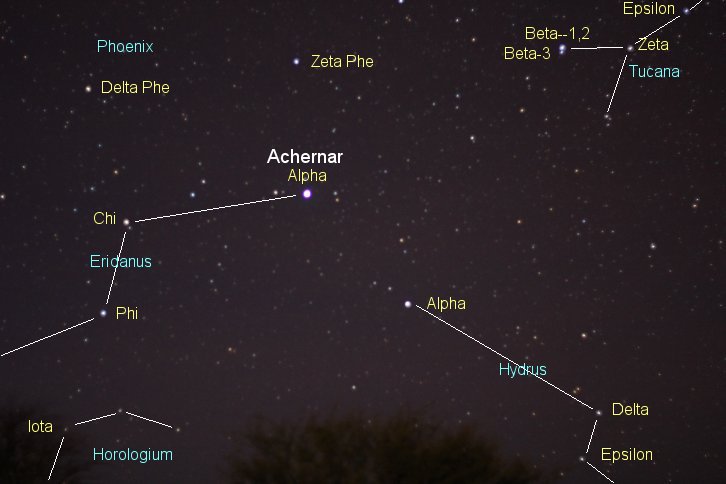Achernar: Binary Star at the End of the River

Achernar is a bright, binary star system in the constellation Eridanus, and is the ninth-brightest star in Earth's night sky. The two stars, Achernar A (seven times the mass of the sun) and Achernar B (which is smaller), rotate about 6.7 Earth-sun distances or astronomical units apart.
Achernar's apparent magnitude — how bright it appears to us — is 0.46. Despite its position in the top 10 stars in the sky, Achernar is sometimes not cited by Northern Hemisphere observers, perhaps because it is invisible above 32 degrees north latitude (approximate location of El Paso, Texas, Nagasaki, Japan, and Tel Aviv, Israel), according to University of Illinois astronomer Jim Kaler. [The Brightest Stars in the Sky: A Starry Countdown]
Achernar means "the end of the river" in Arabic — although the star's official name is Alpha Eridani. It is so far south in Eridanus that it originally was not considered a part of the constellation, according to Kaler. Achernar's location is:
- Right ascension: 1 hour 37 minutes 42.9 seconds
- Declination: -57 degrees 14 minutes 12 seconds
Flat-top spin
Achernar A has a very rapid spin, which astronomers estimated is about 155 miles per second (250 km/s), according to astronomer David Darling. This rapid rotation was first spotted in 2003 observations with the Very Large Telescope. The force of the spin flattens the star considerably, with its equator bulging about 50 percent larger than its poles, Darling added.
"The high degree of flattening measured for Achernar — a first in observational astrophysics — now poses an unprecedented challenge for theoretical astrophysics," he wrote.
"The effect can't be reproduced by common models of stellar interiors unless certain phenomena are incorporated, e.g., meridional circulation on the surface ("north-south streams") and non-uniform rotation at different depths inside the star."
Achernar's rapid spin also make it difficult to measure the star's temperature, Kaler said. Measurements vary between 14,500 to 19,300 degrees Kelvin (roughly 25,640 to 34,280 Fahrenheit, or 14,225 to 19,000 Celsius.) Astronomers say the star is bleeding mass much faster than the sun — thousands of times faster, in fact. "As a result, the diameter and temperature are both hard to determine," he wrote.
"Equally, if not more, important, in an oblate star, the poles are hotter than the equator such that there really is no single defining temperature."
Although Achernar's extreme flattening was a first, other bright stars have been observed with similar effects since then. Vega (which marks the constellation Lyra) has a rapid rotation that causes its equator to be several thousand degrees cooler than its poles.
Altair, which spins at 185 miles (300 kilometers) a second, is at about 90 percent of the velocity it would take to tear the Summer Triangle star apart. That speed is called "critical rotation" among astronomers. Stars that exceed that speed would see their outer layers fling off faster than the internal gravity that seeks to pull them together.
"If stars get to that limit, they will begin to fly apart," said Jason Aufdenberg, a postdoctoral researcher from the National Optical Astronomy Observatory in Arizona in 2006 who was involved in the Vega study.
Kaler added that Achernar A belongs to a class of variable stars called "Lambda Eridani," meaning that there are variations in the light that could be due to "actual complex pulsations or by rotation and dark 'starspots.' " At this point, however, astronomers are not really sure what is responsible, he added.

Join our Space Forums to keep talking space on the latest missions, night sky and more! And if you have a news tip, correction or comment, let us know at: community@space.com.
Get the Space.com Newsletter
Breaking space news, the latest updates on rocket launches, skywatching events and more!

Elizabeth Howell (she/her), Ph.D., was a staff writer in the spaceflight channel between 2022 and 2024 specializing in Canadian space news. She was contributing writer for Space.com for 10 years from 2012 to 2024. Elizabeth's reporting includes multiple exclusives with the White House, leading world coverage about a lost-and-found space tomato on the International Space Station, witnessing five human spaceflight launches on two continents, flying parabolic, working inside a spacesuit, and participating in a simulated Mars mission. Her latest book, "Why Am I Taller?" (ECW Press, 2022) is co-written with astronaut Dave Williams.